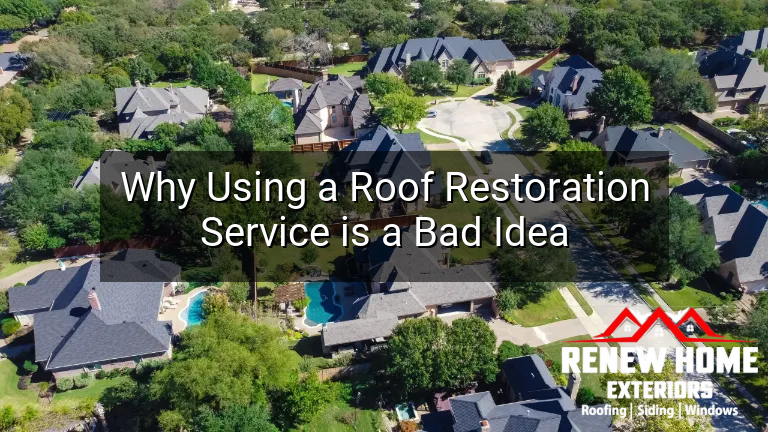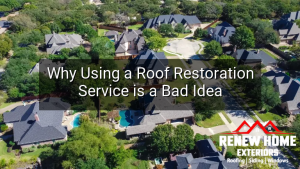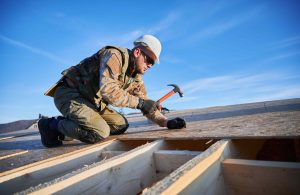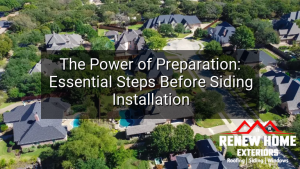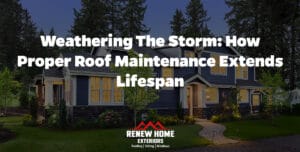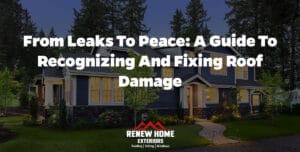Rethinking Roof Restoration: Are They Really Worth It for Northeast Ohio Homeowners?
When it comes to maintaining and revitalizing the roofs of your homes, especially in the ever-changing Northeast Ohio climate, the allure of roof restoration services can be tempting. These services promise to restore your roof’s original beauty, extend its lifespan, and save on the costs associated with complete roof replacement. However, there is a growing concern among homeowners and industry experts alike regarding the cons of roof restoration services. This comprehensive discussion examines why using a roof restoration service might not be the best idea and encourages a shift toward a more thoughtful evaluation of your roofing needs.
At Renew Home Exteriors, we have observed firsthand that while many roof restoration companies claim to offer the magic solution for aging roofs, there are underlying issues that can jeopardize your investment. The restoration process, which typically involves applying a resurfacing coating, may appear cost‐effective at first glance, but once the finer details are uncovered, the risks begin to outweigh the short-term benefits. Homeowners often discover hidden delays, escalating costs, and roof performance issues that leave them with more concerns than solutions.
The purpose of this article is to take a closer look at the potential drawbacks, focusing on the keyword “cons of roof restoration services,” and to provide detailed insights backed by local experiences from Northeast Ohio. We will explore the methodology behind these services, financial vulnerabilities, safety hazards, and how environmental factors may affect the long-term effectiveness of a restoration job. By examining these elements closely, you are empowered to make a more informed decision about whether restoration truly addresses your home’s long-term needs or if investing in a full replacement might be the wiser choice.
Understanding Roof Restoration Services: What You Need to Know
The first step in making an informed decision about roof restoration services is to clearly understand what these services entail. Roof restoration generally refers to the process of repairing and recoating a roof with the aim of reviving its functionality and appearance. This process is typically less invasive than a complete roof replacement, but it involves intricate steps such as cleaning, repairing minor damage, and applying specialized coatings that are intended to seal and protect the roof surface.
The restoration process is marketed as a quick and economical alternative to a full roof replacement. However, this seemingly attractive option comes with its own set of challenges. For instance, the coatings used in roof restoration are not always designed to handle the harsh weather conditions of Northeast Ohio. Over time, these coatings may degrade or peel, leading to further deterioration of the roof structure. Additionally, the restoration process does not permanently fix underlying issues such as poor ventilation or structural weaknesses that may be exacerbated by subsequent weather events.
Moreover, many roof restoration services use one-size-fits-all solutions that may not be appropriate for older roofs or those with unique architectural features. The lack of customization can result in temporary improvements but ultimately fail to provide the long-term benefits that a more thorough repair or replacement might offer. As roofing experts have noted, a patchwork solution may leave your home vulnerable to more extensive and expensive problems down the road.
In addition to technical shortcomings, the process itself can be more problematic than it appears. Questions about the longevity of the materials used, the quality of workmanship, and whether manufacturers’ warranties truly cover all eventualities are often left unanswered. Furthermore, some restoration services might not comply with local building codes or might use sub-standard materials that further compromise your home’s overall safety.
Exploring the Cons of Roof Restoration Services
Despite the apparent benefits advertised by many roof restoration companies, several inherent drawbacks deserve serious consideration. One of the primary concerns is that roof restoration is often seen as a temporary solution rather than a permanent fix. Homeowners may initially be enticed by the promise of raising your roof’s aesthetic value and extending its service life, but these positive effects may only last for a short time, exposing you to major issues sooner than expected.
One of the most talked-about concerns is the limited lifespan of restoration coatings. Many of these coatings are engineered to only last between five to ten years, which means that your roof might require repeated treatment cycles. Over time, these repeated applications do not address the fundamental issues within the roofing structure and may even cause further damage. For example, the accumulation of multiple layers of coatings can obstruct proper drainage, leading to water pooling and seepage – problems that exacerbate as the roof ages.
Another significant downside is the variability in the quality of the job performed. Because roof restoration does not always involve as rigorous an assessment as full replacement, contractors may overlook critical areas that require more comprehensive repair. Inadequate surface preparation, incorrect application techniques, and subpar material quality can all result in a patchwork job that fails to provide lasting protection. As a result, homeowners often find themselves facing unexpected repair bills shortly after restoration services have been performed.
Furthermore, the market for restoration services is cluttered with companies whose credentials are hard to verify. This lack of transparency can leave homeowners vulnerable to substandard workmanship and deceptive practices. Many companies make exaggerated claims about durability and cost savings, and the lack of industry regulation can make it challenging to determine who is truly qualified to perform these services. Such uncertainties emphasize the importance of doing thorough research and questioning the assumptions behind these promises.
Finally, there is an environmental concern linked with repeated roof restorations. Many coatings and chemicals used in these processes are not eco-friendly, and their repeated application over the years can lead to significant environmental degradation. With increasing awareness of environmental sustainability, relying on a process that may contribute to pollution is a major drawback to consider.
Financial Risks and Hidden Costs of Roof Restoration
One of the most compelling arguments against roof restoration services is the financial risk they pose. On the surface, restoration appears to be a budget-friendly option when compared to a full roof replacement. However, the reality is often much different. The initial savings can quickly evaporate as hidden costs emerge and the need for additional repairs becomes apparent. This section delves into the hidden financial risks and offers a detailed assessment of why these services may not be as cost-effective as they seem.
Many roof restoration projects fall victim to unforeseen complications that lead to escalating expenses. The coatings and products used in these services often do not provide the durability promised by the contractor, resulting in premature wear and tear. Homeowners then find themselves facing the financial burden of repeated coats and repairs far sooner than anticipated, a scenario that ultimately undermines the supposed cost benefits. Moreover, inadequate preparation and improper application techniques by inexperienced contractors can result in significant installation errors that cost even more to rectify.
A major financial risk is the potential voiding of existing warranties. When your roof undergoes a restoration process, manufacturers’ warranties that once covered the original installation might be rendered null. This shifts the financial risk entirely on the homeowner, who might then be responsible for any future damages or repairs. In addition, many restoration services have hidden fees that are not clearly communicated at the start. These could include extra costs for labor, material waste disposal, or even additional contingency fees for unexpected repair work.
Another financial consideration is the rapid depreciation in the roof’s value after restoration. Unlike a complete roof replacement that can significantly boost the overall home value through enhanced structural integrity and improved energy efficiency, a restoration is often seen as a short-term fix. Potential buyers or appraisers in the Northeast Ohio area might be skeptical of a roof that has been repeatedly restored rather than replaced, leading to a diminished return on your investment if you decide to sell your home in the future.
Furthermore, for many homeowners, emergency repairs following a failed restoration create a cycle of mounting expenses. Once the restoration fails to deliver, the subsequent need for a full replacement only adds to the overall costs. In the long run, the total expenditure may far exceed the initial budget allocated for the restoration project, making it a financially unsound decision.
Long-Term Implications: How Roof Restoration Can Affect Structural Integrity
The decision to pursue roof restoration services is not merely about immediate costs and repairs—it is also about understanding the long-term implications on your home’s structural integrity. Roofs play a critical role in protecting your entire property. Therefore, any unconventional or short-term solution, such as multiple restorations, can have lasting consequences that compromise the safety and durability of your structure.
One of the major concerns with roof restoration is that it may provide a false sense of security. The fresh appearance of a newly restored roof can overshadow the fact that the underlying roofing structure has not received proper and fundamental repairs. Over time, minor issues such as small leaks and insulation problems, which are often ignored during a restoration process, can escalate into more severe structural weaknesses. These issues are rarely addressed adequately during restoration and may significantly impair the roof’s ability to withstand weather extremes typical in Northeast Ohio.
Moreover, the repeated application of restoration coatings can degrade the original roofing materials faster than anticipated. When restoration products adhere to a roof’s surface, they may create a barrier that prevents the natural expansion and contraction of the nail beds and underlying materials. This interference can lead to cracks, weakened bonding, and an overall decrease in the roof’s performance during severe weather conditions such as heavy snow, rain, or windstorms.
The long-term effects are particularly concerning for older homes, where the restoration process might only mask the inherent weaknesses of an aging roof. In these situations, a superficial fix does not address the fundamental issues—such as deterioration of the underlying wood, rust in metal components, or damaged insulation—which eventually require a full replacement. The temporary nature of restoration can lead to cyclical issues, with homeowners repeatedly investing in restorative work that only delays necessary comprehensive repairs.
Structural engineers and roofing experts emphasize that the longevity and overall integrity of your roof should be the primary concern. By opting for restoration rather than a complete replacement, homeowners risk compromising a valuable element of their property’s defense system. Over time, these long-term implications can result in not only ongoing maintenance headaches but also significant safety hazards that affect the entire home.
Environmental and Safety Concerns with Roof Restoration
The environmental and safety aspects of roof restoration services are increasingly coming under scrutiny. Many homeowners assume that a renovated roof not only enhances the aesthetic appeal but also contributes positively to the environmental sustainability of their home. However, the reality often tells a different story. The chemicals and materials used in restoration processes can have adverse environmental effects and may pose safety hazards to both residents and workers involved in the process.
One of the primary environmental concerns is the use of volatile organic compounds (VOCs) found in many roofing coatings. VOCs are chemicals that can evaporate into the atmosphere during and after application, contributing to air pollution and posing serious health risks upon prolonged exposure. In densely populated areas like Northeast Ohio, repeated applications of such products could exacerbate local air quality issues, affecting both the environment and public health.
In addition to air quality concerns, many restoration products do not adequately degrade over time, resulting in long-lasting chemical residues that can interfere with the natural processes of your surrounding ecosystem. As environmental regulations become more stringent, the long-term impact of these chemicals might lead to legal and maintenance issues that were not initially apparent at the time the restoration was done.
There are also significant safety concerns related to the process of roof restoration. The application of restoration coatings requires specialized equipment, the handling of hazardous chemicals, and often involves working at significant heights. If not conducted with strict adherence to safety protocols, the restoration process can lead to accidents and injuries. Poorly trained contractors or negligent safety practices can increase the likelihood of falls, chemical burns, or other injury-related incidents.
Furthermore, in the event that the restoration process fails to adhere to local building codes and safety standards, homeowners may be at risk of facing litigation or insurance complications. Such issues are compounded if the materials applied trigger allergic reactions or contaminants are not properly disposed of following federal and local guidelines. These challenges highlight the importance of not only evaluating the financial and structural cons of roof restoration but also considering the broader environmental and safety implications.
Alternatives to Roof Restoration: Exploring More Reliable Solutions
Given the numerous cons of roof restoration services—from hidden financial costs to long-term structural implications—it’s important for homeowners to consider more reliable and sustainable alternatives. In Northeast Ohio, where weather extremes demand robust roofing solutions, evaluating all available options becomes crucial in ensuring the longevity and safety of your home.
One alternative to constant roof restorations is a full roof replacement. Although the upfront cost is considerably higher, a new roof comes with enhanced durability, improved energy efficiency, and better compliance with modern building codes. Additionally, full replacements often come with extensive warranties that offer long-term protection, reducing the need for repeated repairs and the associated financial burden over time. Homeowners who opt for full replacements also benefit from modern materials and technologies explicitly engineered to withstand local climatic challenges.
Another viable option is investing in high-quality preventative maintenance programs. Rather than waiting for visible deterioration, regular inspections and minor repairs can keep your existing roof in optimal condition, preventing extensive damage that may require costly restoration or replacement. Many roofing experts in Northeast Ohio advocate for proactive maintenance policies that focus on early detection of potential issues, allowing for timely interventions that extend the life of your roof.
For those looking environmentally forward, selecting eco-friendly roofing materials might be another alternative. The market now offers sustainable roofing solutions that not only provide durability but also contribute positively to energy efficiency. These approaches can include materials with better insulation properties or those that incorporate reflective surfaces designed to minimize heat absorption—features that are particularly valuable in the region’s fluctuating temperatures.
Homeowners may also consider consulting with multiple professional roofing companies to gather a range of opinions and quotes before making a decision. This research will help clarify whether restoration is genuinely the best option, or if alternatives might ultimately offer better long-term value and fewer risks. A comprehensive evaluation of all the available choices, coupled with a keen understanding of your roof’s specific needs, can lead to a more secure and cost-effective investment in your home’s future.
Customer Experiences and Industry Insights on Roof Restoration
Listening to the experiences of fellow homeowners and industry experts can provide valuable insights into the true effectiveness of roof restoration services. Many in the Northeast Ohio community have shared their personal stories and cautionary tales regarding restoration projects that initially promised cost savings and aesthetic improvement, but ultimately led to further complications and expenses.
Several homeowners have reported that after receiving roof restoration services, they were faced with recurring problems such as leaks, bubbling, and even mold growth. Many of these issues stem from the fact that restoration treatments sometimes provide only superficial fixes, leaving underlying structural defects unaddressed. As a result, what began as an attractive, low-cost alternative quickly transformed into a series of ever-increasing repairs that strained household budgets.
Industry experts have also raised concerns about the variability in workmanship and materials used in roof restoration projects. Many professionals in the roofing field emphasize that while restoration may appear to be a quick fix, the process often lacks the comprehensive evaluation necessary for a truly effective solution. In some cases, service providers apply products that are not suited for the specific type of roof or local weather conditions, leading to premature deterioration and compromised performance.
These customer testimonials and expert opinions highlight a broader industry challenge: the absence of standardized quality control in roof restoration services. Without rigorous oversight and certification, it becomes difficult for homeowners to choose a provider that meets acceptable standards. As one local roofing specialist remarked during an industry forum, “It’s critical to look beyond the surface. A restoration that just masks the problems may only delay the inevitable need for a full roof replacement.”
Furthermore, case studies from various neighborhoods in Northeast Ohio have shown that investing in higher-quality restoration or even opting for a replacement can save homeowners from recurring headaches in the long run. The experience of navigating unforeseen repair costs, repeated maintenance cycles, and potential safety hazards reinforces the notion that thorough, upfront investments often pay off better than short-term, superficial fixes.
Weighing the Risks: Making an Informed Roofing Decision
For homeowners considering roof restoration services, the decision ultimately comes down to a careful weighing of the risks and benefits. While the promise of lower upfront costs and improved aesthetics is appealing, a deeper dive into the associated cons of roof restoration services reveals many hidden challenges that can affect the long-term health of your home. This section provides a framework for evaluating all factors and making an informed decision.
First, it is essential to recognize that every roofing project is unique. The state of your roof, the local climate, and the quality of materials available play critical roles in determining the effectiveness of any repair or restoration method. Homeowners should conduct thorough research, engage in multiple consultations, and request detailed workmanship guarantees before finalizing any agreements. Transparent communication with roofing contractors about potential pitfalls and backup plans in case of restoration failure is paramount.
Another critical factor is the long-term financial impact. Although restoration appears to be cost-effective initially, hidden fees, recurring repair costs, and reduced market value can ultimately lead to a higher overall expenditure. Consider employing a comprehensive cost-benefit analysis that compares projected maintenance expenses over the coming years. This analysis can help clarify whether a one-time full roof replacement might offer better value in the long run—a decision that could significantly impact your home’s security and comfort.
In addition to the financial aspects, the decision should also take into account the environmental and safety implications. Ensuring that any work complies with local building codes, adheres to safety standards, and uses environmentally friendly materials should be non-negotiable factors when assessing roofing options. Such careful scrutiny not only protects your investment but also contributes to the overall well-being of your family and community.
Ultimately, the key to making a sound roofing decision lies in a balanced evaluation of both pros and cons. While roof restoration services offer a tempting promise of quick fixes, the cons—ranging from financial risks and lost warranties to long-term structural implications and environmental impacts—highlight the need for caution. By understanding these factors in detail, you are better equipped to choose a solution that provides lasting value, durability, and security for your home.
Pro Tips from Renew Home Exteriors
Pro Tip #1: Conduct a Comprehensive Roof Assessment
Before choosing roof restoration, have your roof thoroughly inspected by independent, certified professionals. This assessment should include a detailed evaluation of the underlying structure, ventilation systems, and existing damage to determine if a superficial restoration is truly viable or if a more extensive repair plan is warranted.
Pro Tip #2: Focus on Long-Term Investment Over Short-Term Savings
While the initial cost of roof restoration may appear budget-friendly, consider the long-term implications. Investing in a full roof replacement or high-quality maintenance now can save you from recurring repair expenses, preserve your home’s value, and provide better protection against Northeast Ohio’s harsh weather conditions.
Pro Tip #3: Choose Eco-Friendly and High-Quality Materials
When evaluating roofing options, prioritize materials that offer durability, sustainability, and adherence to safety and environmental standards. Seek out contractors who use modern, eco-friendly products and who can provide documented case studies or warranties that assure you of long-lasting performance.
Roofing is an investment in the longevity and safety of your home, and every decision you make regarding its repair or replacement has far-reaching consequences. By understanding the hidden cons of roof restoration services, you can avoid pitfalls that may lead to significant financial losses, compromised structural integrity, or environmental hazards. At Renew Home Exteriors, we emphasize an informed approach to home maintenance—one that goes beyond quick fixes and focuses on long-term reliability, durability, and cost-effectiveness. With thorough research, expert consultation, and careful planning, you can safeguard your home against the challenges of aging roofs and ensure that your investment is protected for many years to come. Recognize that while restoration may seem appealing, it often comes with hidden risks that only a well-informed homeowner can manage effectively. Take the time to assess all options and choose a solution that best meets your long-term needs, ensuring that both your home and its occupants remain secure in the face of an ever-changing environment.


